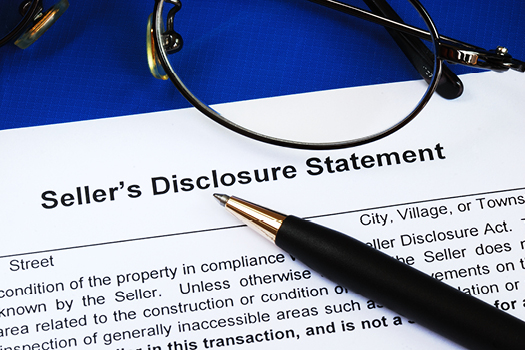The form requires disclosures with respect to a minimum of 16 specific subjects.
- Seller’s expertise in contracting, engineering, architecture or other areas related to the construction and conditions of the property and its improvements
- When the property was last occupied by the seller
- Roof
- Basements and crawl spaces
- Termites/wood-destroying insects, dry rot, and pests
- Structural problems
- Additions, remodeling and structural changes to the property
- Water and sewage systems or service
- Plumbing system
- Heating and air conditioning
- Electrical system
- Other equipment and appliances included in the sale
- Soils, drainage and boundaries
- Presence of hazardous substances
- Condominiums and other homeowners associations
- Legal issues that affect title or would interfere with use and enjoyment of the property
In addition, it is important that you understand the following PA statutes:
68 Pa.C.S.A. § 7303. Disclosure of material defects
Any seller who intends to transfer any interest in real property shall disclose to the buyer any material defects with the property known to the seller by completing all applicable items in a property disclosure statement which satisfies the requirements of section 7304 (relating to disclosure form). A signed and dated copy of the property disclosure statement shall be delivered to the buyer in accordance with section 7305 (relating to delivery of disclosure form) prior to the signing of an agreement of transfer by the seller and buyer with respect to the property.
NOTE: What constitutes a “material defect”? A material defect for these purposes is “a problem with the property or any portion of it that would have a significant adverse impact on the value of the residential real property or that involves an unreasonable risk to people on the land.”
68 Pa.C.S.A. § 7305. Delivery of disclosure form
(a) Method of delivery. The seller shall deliver the property disclosure statement to the buyer by personal delivery; first class mail; certified mail, return receipt requested; or facsimile transmission to the buyer or the buyer’s agent.
(b) Parties to whom delivered. For purposes of this chapter, delivery to one prospective buyer or buyer’s agent is deemed delivery to all persons intending to take title as co-tenants, joint tenants or as a tenant by the entireties with the buyer. Receipt may be acknowledged on the statement, in an agreement of transfer for the residential real property or shown in any other verifiable manner.
NOTE: If your buyer is working with a real estate broker, you can give it to the disclosure form to either the buyer or their agent to consider it “delivered.”
LEAD-BASED PAINT DISCLOSURE
The U.S. Congress passed the Residential Lead-Based Paint Hazard Reduction Act of 1992, also known as Title X, to protect families from exposure to lead from paint, dust, and soil. Section 1018 of this law directed HUD and EPA to require the disclosure of known information on lead-based paint and lead-based paint hazards before the sale or lease of most housing built prior to 1978.
What You Must Do
If the property you are selling was built before 1978, before finalizing a purchase agreement, sellers and landlords must:
- Give the potential buyer an EPA-approved information pamphlet on identifying and controlling lead-based paint hazards (“Protect Your Family From Lead In Your Home” pamphlet).
- Disclose any known information concerning lead-based paint or lead-based paint hazards.
- Provide any records and reports on lead-based paint and/or lead-based paint hazards which are available to the seller; this requirement includes records and reports concerning common areas and other units, when such information was obtained as a result of a building-wide evaluation).
- Include an attachment to the contract or lease (or language inserted in the lease itself) which includes a Lead Warning Statement and confirms that the seller or landlord has complied with all notification requirements.
- Sellers must provide the home buyers a 10-day period to conduct a paint inspection or risk assessment for lead-based paint or lead-based paint hazards. Parties may mutually agree, in writing, to shorten or lengthen the time period allowed for inspection. The home buyer may waive this inspection opportunity. The seller must get this waiver in writing.


